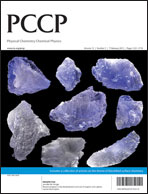We report elastic integral, differential and momentum transfer cross sections for low-energy electron scattering by the cellulose components β-D-glucose and cellobiose (β(1 → 4) linked glucose dimer), and the hemicellulose component β-D-xylose. For comparison with the β forms, we also obtain results for the amylose subunits α-D-glucose and maltose (α(1 → 4) linked glucose dimer). The integral cross sections show double peaked broad structures between 8 eV and 20 eV similar to previously reported results for tetrahydrofuran and 2-deoxyribose, suggesting a general feature of molecules containing furanose and pyranose rings. These broad structures would reflect OH, CO and/or CC σ* resonances, where inspection of low-lying virtual orbitals suggests significant contribution from  anion states. Though we do not examine dissociation pathways, these anion states could play a role in dissociative electron attachment mechanisms, in case they were coupled to the long-lived π* anions found in lignin subunits [de Oliveira et al., Phys. Rev. A, 2012, 86, 020701(R)]. Altogether, the resonance spectra of lignin, cellulose and hemicellulose components establish a physical–chemical basis for electron-induced biomass pretreatment that could be applied to biofuel production.
anion states. Though we do not examine dissociation pathways, these anion states could play a role in dissociative electron attachment mechanisms, in case they were coupled to the long-lived π* anions found in lignin subunits [de Oliveira et al., Phys. Rev. A, 2012, 86, 020701(R)]. Altogether, the resonance spectra of lignin, cellulose and hemicellulose components establish a physical–chemical basis for electron-induced biomass pretreatment that could be applied to biofuel production.

You have access to this article
 Please wait while we load your content...
Something went wrong. Try again?
Please wait while we load your content...
Something went wrong. Try again?
 anion states. Though we do not examine dissociation pathways, these anion states could play a role in dissociative
anion states. Though we do not examine dissociation pathways, these anion states could play a role in dissociative 

 Please wait while we load your content...
Please wait while we load your content...